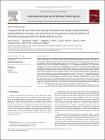| dc.contributor.author | ROGERS, THOMAS RICHARD FRAZER | |
| dc.contributor.author | SMITH, STEPHEN | |
| dc.date.accessioned | 2014-02-26T11:11:43Z | |
| dc.date.available | 2014-02-26T11:11:43Z | |
| dc.date.issued | 2010 | |
| dc.date.submitted | 2010 | en |
| dc.identifier.citation | Walsh F, Cooke NM, Smith SG, Moran GP, Cooke FJ, Ivens A, Wain J, Rogers TR., Comparison of two DNA microarrays for detection of plasmid-mediated antimicrobial resistance and virulence factor genes in clinical isolates of Enterobacteriaceae and non-Enterobacteriaceae, International Journal of Antimicrobial Agents, pending, pending, 2010 | en |
| dc.identifier.other | Y | |
| dc.identifier.uri | http://hdl.handle.net/2262/68152 | |
| dc.description | PUBLISHED | en |
| dc.description.abstract | A DNA microarray was developed to detect plasmid-mediated antimicrobial resistance (AR) and viru- lence factor (VF) genes in clinical isolates of Enterobacteriaceae and non-Enterobacteriaceae. The array was validated with the following bacterial species: Escherichia coli (n = 17); Klebsiella pneumoniae (n = 3); Enterobacter spp. (n = 6); Acinetobacter genospecies 3 (n = 1); Acinetobacter baumannii (n = 1); Pseudomonas aeruginosa (n = 2); and Stenotrophomonas maltophilia (n = 2). The AR gene profiles of these isolates were identified by polymerase chain reaction (PCR). The DNA microarray consisted of 155 and 133 AR and VF gene probes, respectively. Results were compared with the commercially available Identibac AMR-ve Array Tube. Hybridisation results indicated that there was excellent correlation between PCR and array results for AR and VF genes. Genes conferring resistance to each antibiotic class were identified by the DNA array. Unusual resistance genes were also identified, such as blaSHV-5 in a blaOXA-23 -positive carbapenem- resistant A. baumannii. The phylogenetic group of each E. coli isolate was verified by the array. These data demonstrate that it is possible to screen simultaneously for all important classes of mobile AR and VF genes in Enterobacteriaceae and non-Enterobacteriaceae whilst also assigning a correct phylogenetic group to E. coli isolates. Therefore, it is feasible to test clinical Gram-negative bacteria for all known AR genes and to provide important information regarding pathogenicity simultaneously. | en |
| dc.language.iso | en | en |
| dc.relation.ispartofseries | International Journal of Antimicrobial Agents; | |
| dc.relation.ispartofseries | pending; | |
| dc.relation.ispartofseries | pending; | |
| dc.rights | Y | en |
| dc.subject | B-Lactamases | en |
| dc.title | Comparison of two DNA microarrays for detection of plasmid-mediated antimicrobial resistance and virulence factor genes in clinical isolates of Enterobacteriaceae and non-Enterobacteriaceae | en |
| dc.type | Journal Article | en |
| dc.type.supercollection | scholarly_publications | en |
| dc.type.supercollection | refereed_publications | en |
| dc.identifier.peoplefinderurl | http://people.tcd.ie/sgsmith | |
| dc.identifier.peoplefinderurl | http://people.tcd.ie/rogerstr | |
| dc.identifier.rssinternalid | 65376 | |
| dc.rights.ecaccessrights | OpenAccess | |




